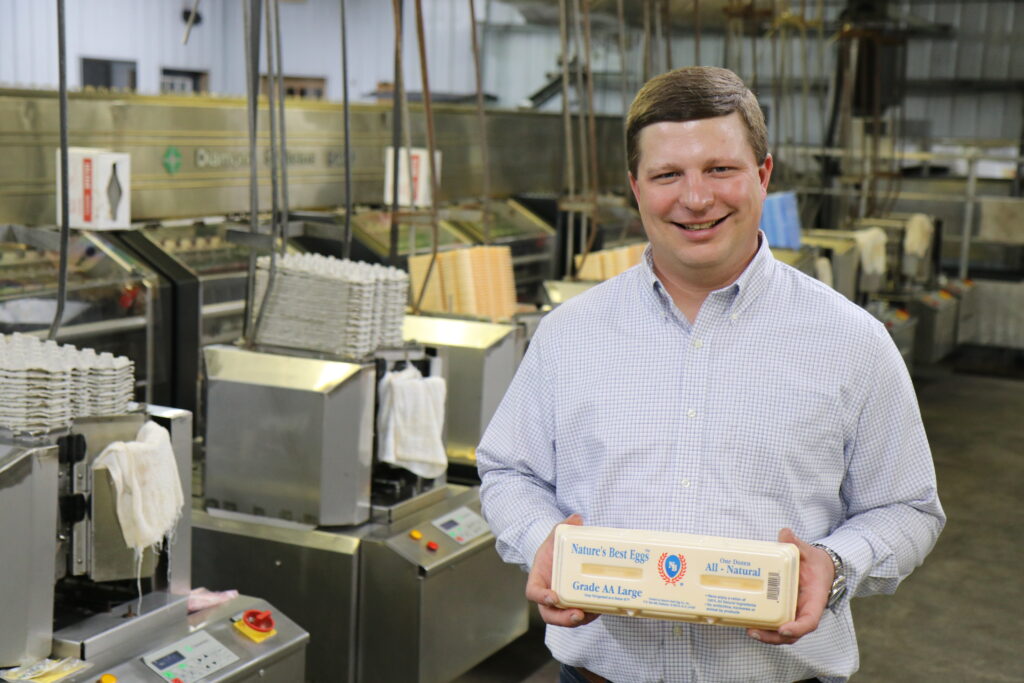Lower Egg Prices Likely Following Easter

By Marlee Moore
After months of elevated egg prices, poultry experts predict consumers will soon shell out fewer dollars per dozen of the popular protein.
Demand will likely decrease following the egg-heavy Easter holiday, said Alabama Farmers Federation Poultry Division Director Colton Christjohn. Meanwhile, flocks are rebounding from an avian influenza outbreak that heavily impacted table egg hens last fall.
“We’re coming off months of holidays where families buy more eggs for baking, breakfast and, now, dyeing,” Christjohn said. “Prices should come down after Easter, but we likely won’t see them back down to where they were.”
Supply And Demand
The average price of a dozen large, Grade A eggs soared from $1.93 in January 2022 to $4.82 in January 2023, according to the U.S. Bureau of Labor Statistics.
Throughout 2022, the rise was gradual, due to global conflicts affecting input costs, plus strict West Coast farming regulations that impact the country, Christjohn said. An extra-egg-centric winter holiday season pressured production, too.
Simultaneously, highly pathogenic avian influenza (HPAI), a virus that is highly contagious in birds, began spreading. HPAI was detected in U.S. wild birds in January 2022, the first finding since 2016. The next month, HPAI was discovered at a turkey farm in Indiana, the first detection in a U.S. commercial flock since 2020.
Flocks in 47 states, including Alabama, have now discovered HPAI, according to the U.S. Department of Agriculture (USDA). Alabama findings were isolated through 2022, including a wild duck in Limestone County; vultures in Montgomery County; and a non-commercial, backyard flock in Lawrence County.
To limit HPAI’s spread, farmers amped up biosecurity measures, and flocks on affected farms were depopulated (58.5 million birds as of March 1). Seventy percent of culled birds were laying hens.
“When you lose that many birds, it drives up egg prices,” Christjohn said.
Production Predicament
Poultry has a $15 billion economic impact annually in Alabama, which has more than 2,500 chicken farmers. Most produce broilers, or meat chickens.
Cullman County farmer Lee Haynes is one of a handful of table egg growers in the state and said production across the U.S. should reach normal levels soon — pending no HPAI outbreaks, which have historically hit larger concentrations of table egg and turkey farms.
“In the last few months, egg farms have had better luck, but it takes a while to restock those chickens,” said Haynes, the local Farmers Federation president. “Everyone has planned their restocking rates, but it’s hard when you lose that many at a time.”
Backyard Birds
High in-store egg prices spiked consumer demand for chicks and backyard bird flocks.
“Backyard flocks have taken off the last few years, but this year, it’s really crazy,” Christjohn said. “One store in Dothan gets about 2,000 chicks a week, and they sell out fast. It’s a race to get into the business.”
But raising backyard chickens doesn’t always ease pocketbook pressure, Christjohn said.
“With current feed prices the way they are, you have to eat more than three eggs per day per household to make it worth having a backyard flock,” he said. “It costs me about 16 cents per day per hen to raise my own backyard birds. That doesn’t take into consideration building the coop and other infrastructure and equipment you need to successfully raise chicks and chickens.”
Biosecurity
Protecting flock health for commercial and backyard flocks is paramount, Christjohn said, noting the importance of biosecurity.
It’s particularly critical on commercial farms, Haynes said. While HPAI leads to increased biosecurity efforts, restricting contact with flocks is standard for poultry farms.
“We limit farm visitors and have a sanitization process poultry house employees go through before entering houses,” Haynes said. “And those workers stay separate from processing employees.”
Haynes said HPAI seems to spike during wild birds’ peak migration seasons of spring and fall. The uncertainty is concerning, but supply is still trending upward.
“HPAI is still out there, and that’s the question — Where does it go from here?” he said. “If we don’t have any more issues, things should start to improve after Easter.”
